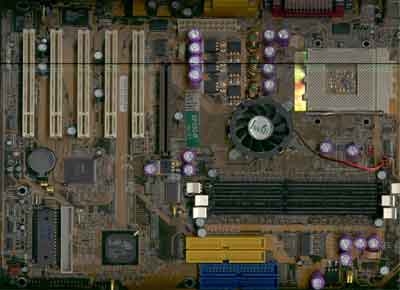VIA KT266A Motherboard Roundup - January 2002
by Mike Andrawes on January 18, 2002 4:48 AM EST- Posted in
- Motherboards
Iwill XP333-R
|
Iwill XP333-R |
|
|
CPU
Interface
|
Socket-A
|
|
Chipset
|
ALi
M1647 North Bridge
ALi M1535D+ South Bridge |
|
Form
Factor
|
ATX
|
|
Bus
Speeds
|
100
- 233 MHz (1MHz increments)
|
|
Core
Voltages Supported
|
1.125
- 1.850 V (in 0.025V increments)
|
|
I/O
Voltages Supported
|
Not
Configurable
|
|
DRAM
Voltages Supported
|
2.5 / 2.6 / 2.7 V
|
|
Memory
Slots
|
3
184-pin DDR DIMM Slots
|
|
Expansion
Slots
|
1
AGP Slot
5 PCI Slots |
|
Onboard
RAID
|
Highpoint
HPT372
|
|
Onboard
USB 2.0/IEEE-1394
|
N/A
|
|
Onboard
Audio
|
C-Media
CMI 8738 Hardware Sound
|
During Comdex we talked to Iwill and learned that they will not be releasing any KT266A motherboards. While we were a little bit disappointed, they quickly pointed out that they would be pushing the XP333-R, the board that uses the new version of the ALi MaGiK 1 chipset.
Upon receiving and testing the board we were very impressed by what the board offers us. Possibly the most impressive thing Iwill has done on the XP333-R is the ability to push the FSB to 166MHz without any problem provided you have some good DDR SDRAM. For all the other boards in this roundup, any FSB speeds of more than 133MHz is considered as overclocking and you take the risks of running into stability problems. However, in Iwill's mind, the XP333-R runs as stable at 166MHz as it is at 133MHz. It's shown in our stress tests that the board didn't fail with either the Athlon-C 1.2GHz or the AthlonXP 1800+ running with a 166MHz FSB.
The XP333-R uses the same C1 stepping of the M1647 North Bridge as the ASUS A7A266-E, so what makes this board so stable at such high FSB while the A7A266-E struggled to stay alive at 160MHz? Besides the careful design of the board to be an overclocker, it also relies greatly in the PCI bus divider. In the BIOS of XP333-R, there is actually an option for you to lower the PCI bus divider to 1/5 or even 1/6. In order to maintain the PCI bus running at 33MHz, you will need a 1/5 divider at 166MHz and a 1/6 divider at 200MHz. By using this setting in the BIOS, we were able to push the FSB all the way to 193MHz before the system lost its stability.
However, if you can't lower your memory bus while increasing the FSB speed, the memory would soon become the bottleneck since most memory aren't designed to run at such high speed. In the original BIOS that came with the XP333-R, the memory and CPU are forced to run at the same bus frequency. But days before the publication of this roundup we received a new BIOS from Iwill that enabled us to run the FSB and the memory bus asynchronously. Therefore you will be able to slow down the memory speed while continuing to increase the FSB of the system.
The XP333-R also comes with the Highpoint HPT372 Ultra ATA133 IDE RAID controller. Together with the updated version of the ALi M1535D+ South Bridge that supports ATA133 as well, you will be able to plug in up to eight Ultra ATA133 devices to the board. The RAID controller also supports RAID 0, 1, and 0+1 functions.
Iwill was the first to include the necessary audio module that takes full advantage of the C-Media CMI8738 6 channel audio, and that's still the case with the XP333-R. With this setup you can simply use the on-board audio to hook up a multi-speaker system.
The board comes in with 3 DIMM slots. While ideally 4 DIMM slots would give users more flexibility, considering that the board has to be 100% stable at 166Mhz and above, it's not surprising that Iwill had to make certain sacrifice.
It's surprising to see what Iwill has done with the ALi MaGiK 1 chipset. The XP333-R is capable of running at 166MHz (333MHz DDR) without any problems, which boosts the performance considerably. The board is also feature rich, making it one of the best AMD motherboards out there now.











3 Comments
View All Comments
Anonymous User - Monday, September 29, 2003 - link
How do I get my Engine to Memory clock to run synchronous for my Epox 8kha+ boardxrror - Saturday, August 14, 2021 - link
This was such an exciting time in PC hardware. Intel was still trying to cram Rambus down the industry's throat - and obstinately trying to strong arm the mobo makers and force chipset makers to Rambus licensing. We still had VIA, SiS, ULi, and even nVidia in the chipset market, and with AMD's Athlon line still extraordinarily competitive and Intel in full attack they could no longer just consider AMD as a side-show - this was their leverage against Intel and they had to treat Socket A as premium platform.NegativeROG - Wednesday, June 15, 2022 - link
I still have this board. AND, I invested all of a $10,000 inheritance in Rambus RDRAM. I'm smarter now (I hope). But, you are right about exciting times in the PC space. I navigated away from AMD for a bit, but came back, and will stay forever. Team RED!